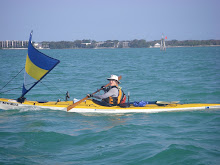An excellent WaterTribe Everglades Challenge this year: terrific but cool northerly tail winds for most of the week; only a night and a few showers of rain on the first day; and best of all, catching up with old and new challengers.
And my favourite post-EC task? Reflecting on what gear performed well for me this year—or didn't—my seventh Everglades Challenge.
The boat: As always, I can't fault my 5.32m Arctic Raider by Graham Sisson. Bitter sweet this year, knowing that Graham has recently retired, after 36 years of designing and making great boats. I cringed doubly, every time (twice) I hit an oyster reef. I really made an effort to keep the weight down this year, and I believe losing a few kilos of gear kept me higher in the waterline and thus less wetted surface, helping to keep the speed up on the down wind rides. (Though I can't be too light a load, as I'll be all over the place.) With the challenging surf conditions on Day 1, running down Sarasota Bay, for example, the boat performed flawlessly.
Greenland paddle: Still using a GP for the race, and loving it. Once again I used a paddle made by EC challenger StripBuilder—a beautifully laminated stick. It was particularly useful side steering when the rudder couldn't cope with fast following seas. And as my spare paddle, I packed along the smaller GP StripBuilder made for my five-year-old son.
Flat Earth Kayak Sail: I cannot rave enough about the Australian FEKS (and I am an agent for selling them in North America!). I did more sailing this year—pretty well having the sail up every day at one time or another—than all previous ECs combined! The first three days, I don't even remember taking it down. Having a FEKS has added a whole new dimension to kayaking, compared with the Pacific Action Sail or other sails designed for kayaking. With the FEKS I arrived at CP1 half-an-hour before dark—100kms (60 miles) after 11 hours and 50 minutes paddle sailing; and did two more record days from Dog Island to Wiggins Pass, arriving before dark on Day 2; and again from Wiggins to CP2, arriving before dark on Day 3. I was beginning to worry I wasn't having a hard enough time! The sail points up into the wind very effectively, bearing in mind you have to keep paddling; the ability to self tack saves much time and energy; and the ability to reef the sail down from 1sq.m. to 0.8sq.m. is downright handy, particularly when beating up to windward, and for rudderless kayaks on a down wind rush.
SPOT tracking system: Thankgoodness for SPOT. Compulsory for some time now for ECs, this handy device means those at home worry far less. I don't paddle without it.
Sleeping system: I tried something new this year, in the interests of saving weight and space. I gave up the sleeping bag (1176g) and replaced it with a Macpac sleeping bag liner (214g), REI lightweight fleece liner (446g), Macpac down Cocoon sleeping bag (all zipless), and a SOL Escape Bivvy (241g) (with an Exped inflatable pillow at 81g). I also replaced the Exped 7 down sleeping mat (which took up its own dry bag and weighs 1165g) with an Exped Airmat Basic 7.5 (550g)—I really like this tiny mat; you can blow it up by mouth (I lie stretched out underneath it in the confines of a one-person tent), and it's not noisy when you move around like the down mat. Everything listed (except for the Cocoon) fitted into one large Sea to Summit dry bag. Most nights were exceptionally cold this year—downright chilly, in fact—often falling near freezing. With all my sacrosanct dry clothes, and all my sleeping layers, including the Bivvy, I was just right. My dry clothes included Macpac fleece leggings and merino socks, a 260 bodyfit Icebreaker top, a Macpac merino top, a NorthFace fleece top, and on top of that a Patagonia Nano Puff Pullover, with an Icebreaker Pocket Beanie on my head (the only lightweight, warm beanie that really covers your ears!). All the clothing fitted into another large Sea to Summit dry bag and weighed in at 1195g.
Tent: As always, my Macpac Microlight, which is not free-standing, but I can string up quite happily on a chickee. At 1.8kg (I have the older version; new is 1.6kg), heaps of solo room, and the inner pitches with the fly. I have been seriously thinking of replacing this tent with the lighter (680g/24oz) Skyscape Trekker from Six Moons Design (or even the slightly heavier and cheaper Scout version at 964g/34oz). In fact, with my encouragement, SandyBottom bought the Trekker version for this year's EC and loves it. But with the very cold night temperatures, I was kind of glad my tent was not a mesh interior, which thus helped to keep a bit more warmth in.
Paddling clothing: Kept it to a minimum, wearing the same outfit every day. This year, I wore a pair of Icebreaker merino boy shorts for underwear (still smelling good after a week!), with a pair of Mysterioso neoprene shorts over those. On top was an Icebreaker 200 Bodyfit Crew top, and for two days in the Wilderness Waterway it was warm enough by day to wear an old long-sleeved REI SPF 50+ polyester shirt. My paddling jacket is a Steve Gurney light racing jacket—sadly he doesn’t make then anymore—and I wore that pretty much every day over my Icebreaker. When it chilled down in the morning and evenings, I put on a Mysterioso fleece top; and for the first time in an EC I actually wore my Mysterioso fleece trousers, over my shorts.
Wet weather gear: Once again, my Reed Chillcheater Coverall cag was invaluable. With the cool morning and evening temperatures, I was snug and warm. The cag is measured to fit my ocean cockpit rim, offering double protection from the waves over the sprayskirt. I've now learned to fit my PFD over the cag—though it's designed to fit over the PFD—as the wind tends to fill the cag and make forward progress pretty difficult.
Lighting system: The head lamp I used the most is the Petzl Tikka XP 2, which I was very happy with. (I usally use the Underwater Kinetics 3AAA eLED Vizio Headlamp, which is excellent—light and comfy—but my son has put it in a very safe place... somewhere.) For spotting camp sites in the pitch black I use a Fenix HP10, which I recommend.
GPS: I use a Garmin GPSMAP 76CSx. For years I've had the GPS on a Ram Mount ahead of me, out of paddle hit reach. After a day or two of not being able to read it—a mix of light and older-age eyes—I just looped the unit to my sprayskirt and had it right in front of me, resting on my sprayskirt. I reckon I'll now pop it into a dry bag, and hopefully get a few more years out of it.
Food: I really thought I'd cut it down this year—and didn't! I made up a daily pack of six Nature Valley Oats ‘N Honey (my favourite), a Cliff 20g protein Builder’s Chocolate Mint, a Honey Stinger Protein Bar, one Larabar (non-fruit), three gels and a small Ziploc of dried mango. That weighed around 670g of snack food a day, totaling around 4720g in total. In the end, I ate less than three days worth, which left a lot of weight not eaten.
I did eat all my breakfasts: per day, 7 dried apricots, an Ensure (350cals) and a Luna bar.
And for once, I nearly ate all my dinners: per evening, an Ensure (350 cals), and either a tin of sardines (2) or a freeze dried (3)—I never normally have the stomach for an evening freeze dried, but the shorter paddling days helped.
And I still lost around 3.5k (8lbs).
Cooking system: For the first time, I used a JetBoil this year—a few months ago I was extremely lucky to snag a Sol Ti for $38—normally around $150. Loved it—had the water boiling in a matter of what seemed like seconds. Downsides: only boils enough water for one (hence the 'sol", I suppose), and the neoprene cover and handle is downright useless for lifting to pour. I'll be contacting Jetboil for a heavier handle. Having the Jetboil saved 555g on my cooking system.
Personal health: I worked really hard at this this year, and now have my routine down pat—and what a difference. In previous ECs, my derriere has suffered. Every morning I lather myself with Desitin, and I really believe wearing the Icebreaker merino underwear made a huge difference (let alone keeping on smelling fine!). But the evening routine is crucial: pitch the tent; throw in the tent all the gear for the evening (and breakfast); strip and pile the wet clothes somewhere; wipe myself down all over with two wet ones; slap baby powder all over the body—particularly the feet and rump—making sure everything's dry; rub Joshua Tree paddler's salve into my feet (and hands); and pull on all your sacrosanct dry clothes. Reverse in the morning.
As always, I religiously used my SunPaws, from Hydraulics in NZ—anything to cut out the sun on the back of the hands. And this year, I was not going to have my face or lips burned, and with a Kokatat Nor'wester sun hat religiously used a High UV Protection Buff. I cannot swear enough by the Buff.
Pre-race training: I really worked at it this year. Having a competitive derby program to work for against many of my fellow challengers really helped this season, keeping up almost daily four-mile 0500 walks; 25 minutes of core exercises every other day (I can now do 100 full length push ups! in reps of 10), and a 25-mile paddle most Sundays. But much of an EC is all mental, and for that I am well
prepared.
Coming up: Day-by-day blows of the race.
Previous EC gear reflections:
EC2011
EC2010
EC2009
EC2008
EC2007







3 comments:
If you re-use your paddle clothes veryday, do you find the salt building up on them day by day?
Congrats on another great EC adventure KiwiBird! Good to know you're still at it and doing well. Also once again I enjoyed reading your 'gear issue'... Informative and interesting as always!
Best wishes to you all (oh, and hope you discover that really, really safe hiding spot soon!).
Michael
Good question, Wade. The only salt build up really happens on the Icebreaker and the polyester tops--the sleeves get a bit shorter each day and the polyester hardens up a bit. The beauty of Icebreaker is that it stays supple, and the merino is cooling in warmish temperatures and warming in cool temps. Salt build up is really only confined to the arms--the PFD tends to protect the torso, leaving just sweat.
Post a Comment